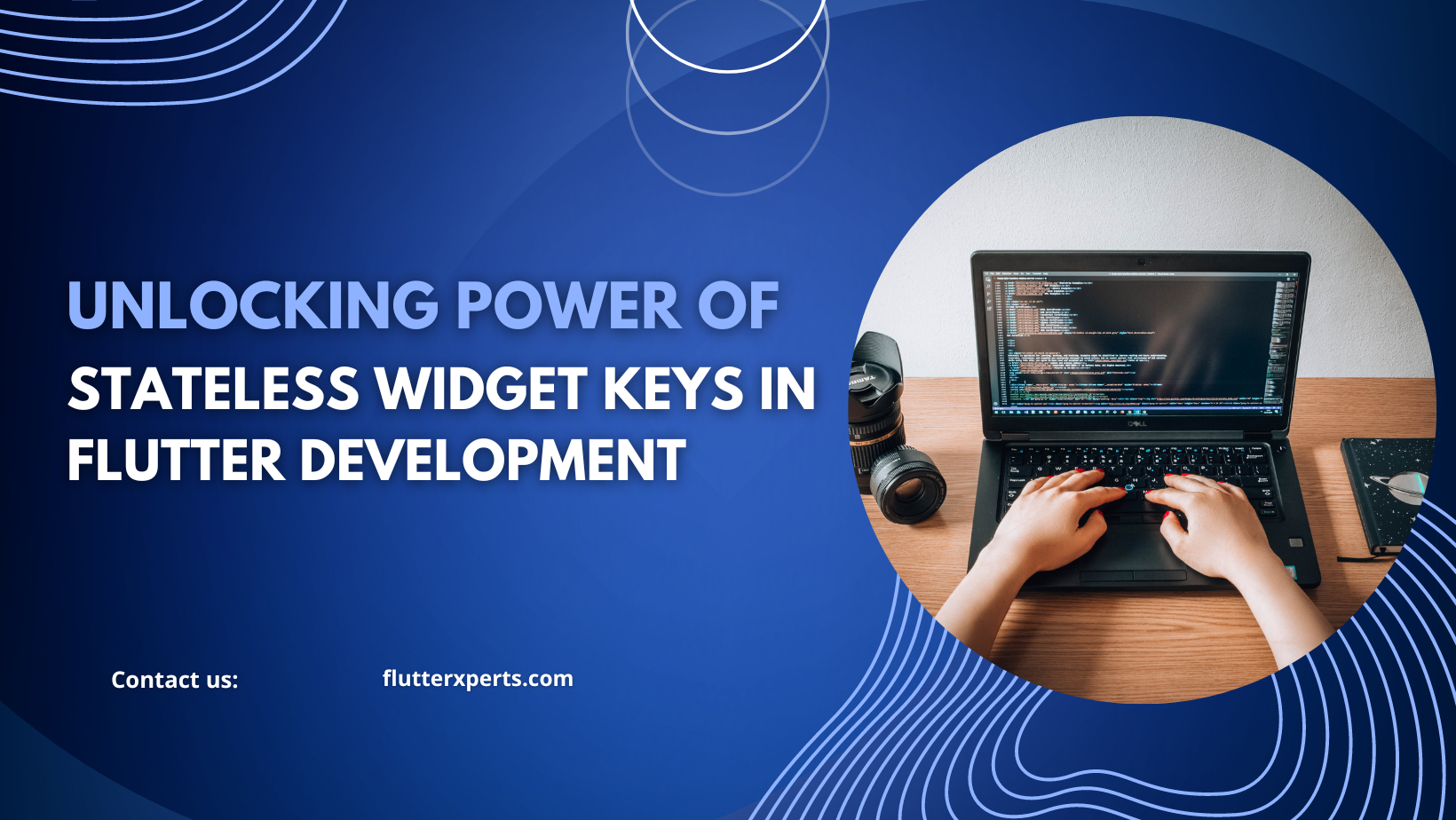Understanding Keys in the Stateless Widgets Class: A Comprehensive Guide to Flutter Development
Introduction to the Stateless Widgets Class
The Flutter framework provides a wide range of widgets for building user interfaces, and one of the fundamental concepts in Flutter development is the “StatelessWidget” class. In this blog, we will explore the concept of keys in the stateless widgets class and how they contribute to Flutter app development.
Understanding Keys in Flutter
Keys play a crucial role in Flutter when it comes to managing and identifying widgets efficiently. In simple terms, a key is an identifier assigned to a widget, allowing Flutter to differentiate between different instances of the same widget type. Keys are particularly important in scenarios where the widget tree is dynamically updated or rebuilt.
Importance of Keys in Stateless Widgets
Keys are essential in stateless widgets because they help Flutter recognize and preserve the state of widgets during widget tree updates. By assigning a key to a widget, you inform Flutter that this specific widget instance has a unique identity, even if its properties are identical to other widgets of the same type.
Using Keys for Widget Identification
In Flutter, keys are used to match and identify widgets during the widget tree update process. When Flutter rebuilds the widget tree, it compares the keys of old and new widgets to determine if they represent the same underlying data or state. By using keys effectively, you can optimize the rendering process and ensure that only the necessary widgets are updated.
To assign a key to a stateless widget, simply pass a unique key object to the “key” parameter when creating the widget. For example:
Widget build(BuildContext context) {
return Container(
key: UniqueKey(),
// Widget properties...
);
}
Avoiding Widget State Loss with Keys
One of the common challenges in Flutter app development is preserving the state of widgets when the widget tree is rebuilt. This issue can occur, for instance, when a user interacts with a widget, triggering a rebuild, and causing the widget to lose its state.
By using keys, you can ensure that widgets retain their state across widget tree updates. When Flutter rebuilds the widget tree, it matches widgets based on their keys, allowing them to preserve their state seamlessly. This is especially valuable when working with user input forms, animations, or complex UI components.
Common Use Cases and Best Practices for Keys in Flutter
While keys are useful in various scenarios, some common use cases include:
- ListViews and Dynamic Lists: When working with dynamic lists or ListViews in Flutter, assigning keys to individual items enables smooth item updates and animations.
- Reordering and Sorting: By assigning keys to list items, you can reorder them without losing their state or triggering unnecessary widget updates.
- Removing and Adding Widgets: When widgets are added or removed dynamically, using keys ensures the correct identification and preservation of widget state.
To make the most of keys in your Flutter app, consider the following best practices:
- Use Unique Keys: Ensure that each key assigned to a widget is unique within its parent context. This uniqueness guarantees proper identification and prevents unintended issues.
- Avoid Changing Keys: Keys should remain stable throughout the widget’s lifecycle. Changing keys can lead to unexpected behavior and unnecessary widget rebuilds.
Advanced Techniques with Keys in the Stateless Widgets Class
While the basic usage of keys is straightforward, advanced techniques can further enhance their effectiveness in managing widget state and performance. Some of these techniques include:
- Global Keys: Using GlobalKey instances, you can access and manipulate widgets across different parts of your app, even outside the widget tree hierarchy.
- Keyed Subtrees: By defining key boundaries around groups of widgets, you can limit the impact of updates within specific sections of your app, improving performance.
- Stateful Widgets and Keys: Combining stateful widgets with keys can provide more fine-grained control over widget state and updates.
Troubleshooting Common Issues with Keys
While working with keys in Flutter, you may encounter some common issues and pitfalls. Here are a few tips to help you troubleshoot and overcome them:
- Key Conflicts: Ensure that keys within a widget tree are unique. Duplicate keys can lead to unexpected behavior and conflicts during widget updates.
- Forgetting to Assign Keys: Remember to assign keys to stateless widgets when necessary. Forgetting to include keys may result in unnecessary widget rebuilds and potential state loss.
- Inconsistent Key Usage: Use keys consistently across all relevant widgets. Inconsistent key usage can introduce inconsistencies and unpredictable behavior.
Here’s a complete example that demonstrates how to utilize keys in Flutter:
import 'package:flutter/material.dart';
class MyWidget extends StatelessWidget {
const MyWidget({Key? key}) : super(key: key);
@override
Widget build(BuildContext context) {
return Container(
key: key,
color: Colors.blue,
child: Center(
child: Text(
'My Widget',
style: TextStyle(color: Colors.white, fontSize: 24),
),
),
);
}
}
class MyApp extends StatefulWidget {
const MyApp({Key? key}) : super(key: key);
@override
_MyAppState createState() => _MyAppState();
}
class _MyAppState extends State<MyApp> {
Key _widgetKey = UniqueKey();
void _changeWidget() {
setState(() {
_widgetKey = UniqueKey();
});
}
@override
Widget build(BuildContext context) {
return MaterialApp(
home: Scaffold(
appBar: AppBar(
title: const Text('Key Example'),
),
body: Column(
children: [
MyWidget(key: _widgetKey),
ElevatedButton(
onPressed: _changeWidget,
child: Text('Change Widget'),
),
],
),
),
);
}
}
void main() {
runApp(MyApp());
}
In this example, we have a MyWidget class that represents a custom widget. The key parameter is passed to the Container widget to assign a key to the widget. The MyWidget widget displays a blue container with centered text.
The MyApp class represents the main application. It contains a stateful widget _MyAppState that manages the state of the app. The _widgetKey variable holds the key for the MyWidget instance.
The _changeWidget function is called when the “Change Widget” button is pressed. It generates a new unique key using UniqueKey(), triggering a state update and rebuilding the MyWidget widget.
Finally, the MyApp widget is wrapped with a MaterialApp and Scaffold to provide the app’s structure and layout. The Column widget contains the MyWidget instance and a button that calls the _changeWidget function.
By assigning a key to MyWidget and updating it with a new unique key, we can trigger a rebuild of only that specific widget instead of rebuilding the entire widget tree. This approach improves performance and avoids unnecessary updates to other widgets.
Remember to import the necessary packages (import 'package:flutter/material.dart';) for the code to work correctly.
Conclusion
In this comprehensive guide, we have explored the concept of keys in the stateless widgets class of Flutter. Understanding and utilizing keys effectively can significantly improve the performance, state management, and update efficiency of your Flutter apps. By assigning unique keys to widgets, you enable Flutter to optimize the rendering process and preserve widget state seamlessly.
We have covered the importance of keys, how to use them for widget identification, avoiding widget state loss, common use cases, best practices, advanced techniques, and troubleshooting tips. By following these guidelines, you can harness the power of keys in Flutter development and build high-quality, efficient, and responsive mobile applications.
FAQs
Q: Can keys be used with stateful widgets as well? A: Yes, keys can be used with both stateless and stateful widgets. Keys provide a mechanism to identify and manage the state of widgets during updates.
Q: What happens if I assign the same key to multiple widgets within the same parent? A: Assigning the same key to multiple widgets within the same parent can result in conflicts and unpredictable behavior. Ensure that keys are unique within their respective parent context.
References:
- Flutter documentation: Keys
- Flutter.dev tutorial: Understanding Keys in Flutter


